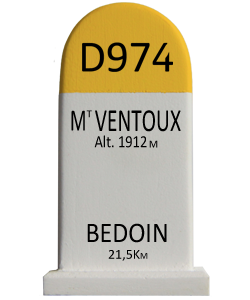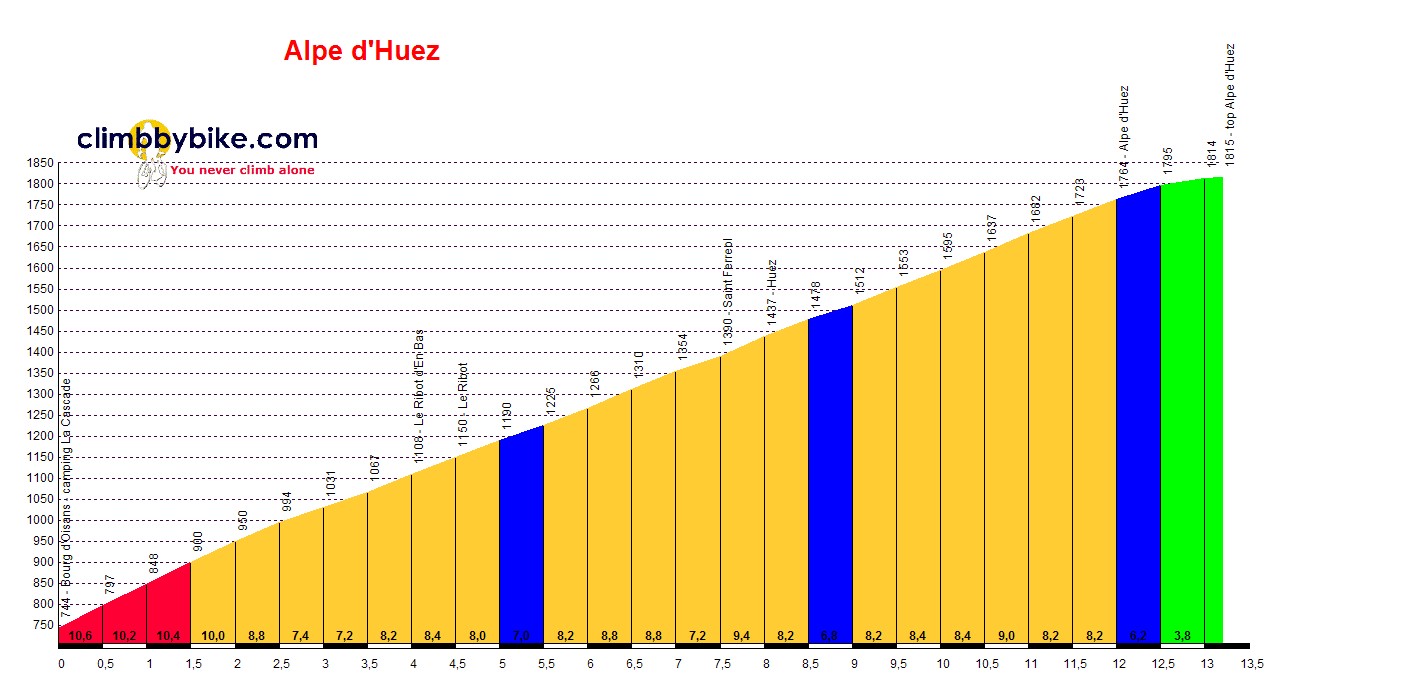Alpe d'Huez - Bourg d'Oisans

Cycle racing
|
|
There is a proposal that this section be split into a new article titled [[::Climb of l'Alpe d'Huez|Climb of l'Alpe d'Huez]]. (Discuss) (July 2015) |
Details of the climb
The climb to the summit starts at Le Bourg d'Oisans in the Romanche valley. The climb goes via the D211 from where the distance to the summit (at 1,860 m (6,102 ft)) is 13.8 km (8.6 mi), with an average gradient of 8.1%, with 21 hairpin bends and a maximum gradient of 13%.[7] In 2013, the finish of Stage 18 of the Tour de France, was at 1,850 m (6,070 ft) with the first passage being at a maximum altitude of 1,765 m (5,791 ft).[8]
Tour de France
L'Alpe d'Huez is climbed regularly in the Tour de France. It was first included in the race in 1952 and has been a stage finish regularly since 1976.[7]
The race was brought to the mountain by Élie Wermelinger, the chief commissaire or referee.[9] He drove his Dyna-Panhard car between snow banks that lined the road in March 1952, invited by a consortium of businesses who had opened hotels at the summit.[10] Their leader was Georges Rajon, who ran the Hotel Christina.[11] The ski station there opened in 1936. Wermelinger reported to the organiser, Jacques Goddet, and the Tour signed a contract with the businessmen to include the Alpe.[10] It cost them the modern equivalent of €3,250.[11]
That first Alpe d'Huez stage was won by Fausto Coppi.[9] Coppi attacked 6 kilometres (3.7 miles) from the summit to rid himself of the French rider Jean Robic.[9][12] He turned the Alpe into an instant legend because this was the year that motorcycle television crews first came to the Tour.[9] It was also the Tour's first mountain-top finish.[13] The veteran reporter, Jacques Augendre, said:
- The Tourmalet, the Galibier and the Izoard were the mythical mountains of the race. These three cols were supplanted by the Alpe d'Huez. Why? Because it's the col of modernity. Coppi's victory in 1952 was the symbol of a golden age of cycling, that of champions [such as] Coppi, Bartali, Kubler, Koblet, Bobet. But only Coppi and Armstrong and Carlos Sastre have been able to take the maillot jaune on the Alpe and to keep it to Paris. That's not by chance. From the first edition, shown on live television, the Alpe d'Huez definitively transformed the way the Grande Boucle ran. No other stage has had such drama. With its 21 bends, its gradient and the number of spectators, it is a climb in the style of Hollywood.[12]
Augendre neglected to mention Fignon, who, along with Coppi and Armstrong, took yellow on the Alpe without winning the stage in 1983, 1984, and 1989. He held it into Paris in 1983 and 1984 but in 1989 he lost it on the final stage to Paris, a time trial, to Greg LeMond to finish second by 8", the closest finish in tour history.
After Coppi, however, the Alpe was dropped until 1964, when it was included as a mid-stage climb, and then again until 1976,[14] both times at Rajon's instigation.[11]
The hairpin bends are named after the winners of stages. All hairpins had been named by the 22nd climb in 2001 so naming restarted at the bottom with Lance Armstrong's name added to Coppi's.
French journalist and L'Equipe sportswriter Jean-Paul Vespini wrote a book about Alpe d'Huez and its role in the Tour de France: The Tour Is Won on the Alpe: Alpe d'Huez and the Classic Battles of the Tour de France.
Spectators
The Alpe has chaotic crowds of spectators. In 1999, Giuseppe Guerini won despite being knocked off by a spectator who stepped into his path to take a photograph. The 2004 individual time trial became chaotic when fans pushed riders toward the top. Attendance figures on the mountain have to be treated with caution. A million spectators were claimed for 1997. Eric Muller, the mayor of Alpe d'Huez, however, said there were 350,000 in 2001, four years later despite acceptance that the number rises every year. "We expect more than 400,000 for the centenary race in 2003," he said.[15] The author Tim Moore wrote:
As a variant on a sporting theme, Alpe d'Huez annoys the purists but enthrals the broader public, like 20/20 cricket or beach volleyball. Last year, a full-blown tent-stamping riot had required heavy police intervention. During this year's clean-up operation, down in a ravine with the bottle shards and dented emulsion tins, a body turned up. He'd fallen off the mountain and no one had noticed. When the Tour goes up Alpe d'Huez, it's a squalid, manic and sometimes lethal shambles, and that's just the way they like it. It's the Glastonbury Festival for cycling fans.[16]
Alpe d'Huez has been nicknamed the "Dutch Mountain",[17] since Dutchmen won eight of the first 14 finishes in de Tour De France. British author Geoffrey Nicholson wrote:
The attraction of opposites draws [Dutch spectators] from the Low Countries to the Alps each summer in any case. But all winter in the Netherlands coach companies offer two or three nights at Alpe d'Huez as a special feature of their alpine tours. And those Dutch families who don't come by coach, park their campers and pitch their tents along the narrow ledges beside the road like sea-birds nesting at St Kilda. The Dutch haven't adopted the Alpe d'Huez simply because it is sunny and agreeable, or even because the modern, funnel-shaped church, Notre Dame des Neiges, has a Dutch priest, Father Reuten (until a few years ago, it was used as a press room and was probably the only church in France where, for one day at least, there were ashtrays in the nave and a bar in the vestry, or where an organist was once asked to leave because he was disturbing the writers' concentration). No, what draws the Dutch to Alpe d'Huez is the remarkable run of success their riders have had there."[18]
Significant stages
1952: Jean Robic attacked at the start of the climb and only Fausto Coppi could stay with him. The two climbed together until Coppi attacked at bend five, four kilometres from the top. He won the stage, the yellow jersey and the Tour.
1977: Lucien Van Impe, a Belgian rider leading the climbers' competition, broke clear on the Col du Glandon. He gained enough time to threaten the leader, Bernard Thévenet. He was still clear on the Alpe when a car drove into him. The time that Van Impe waited for another wheel was enough to keep Thévenet in the lead by eight seconds.
1978: Another Belgian leading the mountains race also came close to taking the yellow jersey. Michel Pollentier also finished alone, but he was caught soon afterwards defrauding a drugs control and was disqualified.
1984: The Tour invited amateurs to take part in the 1980s. The best was Luis Herrera, who lived at 2,000m in Colombia. None of the professionals could follow him. He won alone to the cacophony of broadcasters who had arrived to report his progress.
1986: Bernard Hinault said he would help Greg LeMond win the Tour but appeared to ride otherwise. The two crossed the line arm in arm in an apparent sign of truce.
1997: Marco Pantani, who won on the Alpe two years earlier, attacked three times and only Jan Ullrich could match him. He lasted until 10 kilometres (6.2 miles) from the summit and Pantani rode on alone to win in what is often quoted as record speed (see below).
1999: Giuseppe Guerini, who broke away on his own, collided with a spectator but got up and went on to win the stage.
2001: Lance Armstrong feigned vulnerability earlier in the stage, appearing to be having an off-day. At the bottom of the Alpe d'Huez climb, Armstrong moved to the front of the lead group of riders and then looked back at Jan Ullrich. Armstrong later commented that he wasn't looking back at Ullrich but was actually looking back to see the position of his team mate Tyler Hamilton. Seeing no response from Ullrich, Armstrong accelerated away from the field to claim the victory, 1:59 ahead of Ullrich. Armstrong would later be stripped of this achievement and his tour win by his conviction for doping in 2012. His name however, is still honoured on one of the 21 signs of previous winners, lining the road of Alpe D'huez.
2013: Christophe Riblon won the stage at the summit of Alpe d'Huez during the 100th edition of the Tour. For the first time ever, riders rode up the climb twice with the descent over the Col de Sarenne in between.
Winners
*In 1979 there were two stages at Alpe d'Huez.
† Stage 18 of the 2013 Tour climbed to Alpe d'Huez twice.[20] Moreno Moser was the leader at the first time over the summit.
Fastest ascents
The climb has been timed since 1994 so earlier times are subject to discussion. From 1994 to 1997 the climb was timed from 14.5 kilometres (9.0 miles) from the finish. Since 1999 photo-finish has been used from 14 kilometres (8.7 miles). Other times have been taken 13.8 kilometres (8.6 miles) from the summit, which is the start of the climb. Others have been taken from the junction 700m from the start.[21]
These variations have led to a debate. Pantani's 37m 35s has been cited by Procycling and World Cycling Productions, publisher of Tour de France DVDs, and by Cycle Sport. In a biography of Pantani,[22] Matt Rendell notes Pantani at: 1994 – 38m 0s; 1995 – 38m 4s; 1997 – 37m 35s. The Alpe tourist association describes the climb as 14.454 kilometres (8.981 miles) and lists Pantani's 37m 35s (23.08 km/h) as the record.[23]
Other sources give Pantani's times from 1994, 1995 and 1997 as the fastest, based on timings adjusted for the 13.8 kilometres (8.6 miles).[24] Such sources list Pantani's time in 1995 as the record at 36m 40s. In Blazing Saddles, Rendell has changed his view and listed it as 36m 50s[25] as does CyclingNews.[23] Second, third, and fourth fastest are Pantani in 1997 (36m 45s), Pantani in 1994 (37m 15s) and Jan Ullrich in 1997 (37m 30s). Armstrong's time in 2004 (37m 36s) makes him fifth fastest, highlighting how the 1990s had faster ascents than other eras.
A number of cycling publications cite times prior to 1994, although distances are typically not included, making comparisons difficult. Coppi has been listed with 45m 22s for 1952.[24]
In the 1980s Gert-Jan Theunisse, Pedro Delgado, Luis Herrera, and Laurent Fignon rode in times stated to be faster than Coppi's, but still not breaking 40m. Greg LeMond and Bernard Hinault have been reported as having the times of 48m 0s in 1986.[26]
It was not until Gianni Bugno and Miguel Indurain in 1991, that times faster than 40m were reported, including in the 39m range for Bjarne Riis in 1995 and Richard Virenque in 1997.
Ascent times
| This section does not cite any sources. (August 2013) |
Based on 14.454 km[clarification needed]
* The 2004 stage was an individual time trial.
Other cycle races
The peak is also finish of La Marmotte, a one-day, 175 km (109 mi) ride with 5,000 m (16,400 ft) of climbing.
Mountain biking
The resort caters for mountain bikers during the summer months, the pinnacle of which is the Megavalanche, a 'Downhill Enduro' Event that takes riders from lift station at the highest peak, Pic Blanc, to Allemont in the valley floor.
Triathlon
Since 2006 Cyrille Neveu has organized the Triathlon EDF Alpe d'Huez, which has become a major summer attraction.





